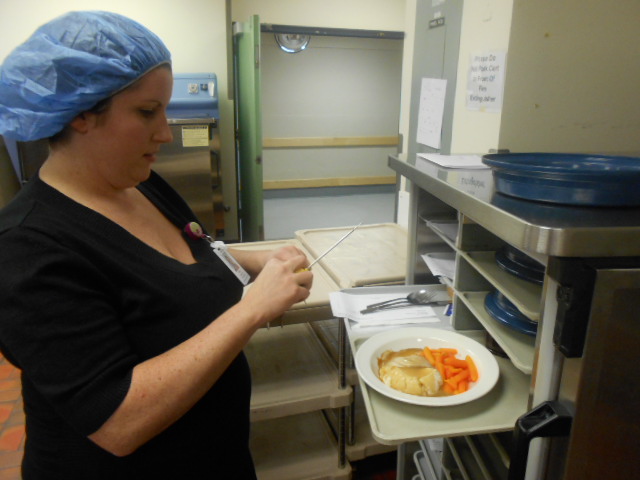EDITORIAL: HOSPITAL FOOD IN OUR REGION
A recent scathing opinion piece by Murray Dobbin outlined the shortcomings of food in some health care facilities administered by the Vancouver Coastal Health Authority (VCHA). Both the quality and the quantity of the food served were reported as inadequate, even for institutional food which is understandably challenging to prepare and to serve on individual trays delivered to a large number of people with varying dietary requirements while still maintaining flavour, nutrition, and general appeal.
In the VCHA, food service has been privatized. The contractor is a company called Sodexo, and both Sodexo and VCHA came in for heavy criticism from Dobbins. But what about our area, served by the Interior Health Authority (IHA)?
When asked, IHA personnel went out of their way to answer questions and provide a tour of the food-preparation facility in the Kootenay Boundary Regional Hospital (KBRH) in Trail, while meal trays were being prepared and re-heated — or “re-thermalized,” which seems to be the preferred official term, and sounds laughably as if someone spent some time inventing a term to “spin” re-heating and make it sound less pejorative. Laresa Altenhoff, the manager for support services (food, housekeeping and laundry) for IH East (Kootenays), led the tour and provided information.
IHA has not privatized its food services, though in 2003 it centralized much of the food preparation to a facility in Vernon, and installed special re-heating ovens in the Trail hospital and other facilities. The IHA system makes only main dishes such as casseroles, meatloaf and roasts at the centralized food prep centre in Vernon, then flash-freezes them and ships them frozen in case lots to the different hospitals and care facilities for thawing, portioning onto trays and re-heating. Transporting the frozen food is the only part of the operation that has been contracted out to a private business, Sysco.
There was some reduction in KBRH staff with the centralization, and one staff member moved from KBRH to take a job at the new facility in Vernon.
Altenhoff says that staff now have the new system working well, but she acknowledges that back in 2003 when the centralized system began, it was “a long experiment” and that the results could be disappointing until staff figured it out. In 2004, KBRH revamped the kitchen to make it function better with the new system. She admits that they still get some complaints about food, and mentions that some people miss having more salt, fat and sugar in their food than the hospital provides.
Each care facility still has its own kitchen and its own cooks, and still makes its own soups, sandwiches and salads as well as cooking its own hot cereals and starches such as pasta and rice. The meals are not assembled onto trays at the Vernon facility and then shipped out, though that system is in place elsewhere; Winnipeg was given as an example. Staff indicated that though that system may be more efficient, it is “perhaps not as patient-friendly” as IHA’s system, which enables on-site staff to adjust meals to individual patient needs and preferences more readily. Patients fill out a menu sheet every evening expressing their preferences for the following day.
IHA facilities serve the day’s main meal at mid-day, and in the evening serve lighter fare such as soups, sandwiches and salads.
At KBRH, a meal tray is assembled for each patient according to an information card that tells kitchen staff what that patient needs and prefers, and within the limitations of the day’s menu and the patient’s medical needs, that’s what is served. There are special meals for diabetic patients, patients with difficulty swallowing, allergies, gluten-free needs, vegetarian diets, and so on.
The food is placed on trays divided into two sections; a hot section and a cold section. When the trays are placed in the heating units, only the hot side of each tray is heated; the cold side is kept separate by an insulated divider. When the food has been in the heating unit for the time estimated to be enough, a staff member takes a test tray out and checks the temperature of the hot food. If it’s hot enough, the trays all come out for distribution; if it isn’t, they go in for a bit more heating. The heat is normal dry oven heat, not microwave or steam heat.
Altenhoff emphasized that staff do their best to accommodate individual patient needs, while admitting that human error does occur sometimes. She also emphasized that IHA facilities do not run out of food for patients. For residential-care facilities such as Poplar Ridge and Columbia View, it is a licensing requirement that patients are able to have second helpings, if they wish.
How many patients are fed in Trail health facilities alone? KBRH usually has 75 acute-care patients to feed, plus another 50 residents in Poplar Ridge extended-care unit, attached to KBRH. Columbia View Lodge, the extended-care unit on Laburnum Drive, has 76 residents and also feeds 20 adult day-program patients a mid-day meal and two snacks, from Monday to Saturday.
The KBRH kitchen staff have snacks and bag meals ready for unexpected patients, and they also prepare frozen “Dinners At Home” for patients discharged to the community who find cooking for themselves a challenge. They serve clients from Fruitvale to Rossland — but someone does have to pick up the meals. The gift shop sells them for about $6.25 each.
Food waste is a concern, and KBRH has found a way to benefit the local community by giving left-over food to organizations such as Sanctuary — following strict FoodSafe rules.
Let’s face it: hospital food is prepared in large quantities and has to be delivered on carts up elevators and down long hallways, by staff who are in a hurry to get it all delivered while it’s still hot. It can’t be like home-cooked meals (unless your home has a rather lackadaisical cook) or like restaurant meals, which tend to be high in salt and fats. But judging by the efforts made in the kitchens at KBRH and Columbia View Lodge, and the reports in Dobbins’s article, patients in the IHA region are much better served with regard to food than those in the VCHA region.

























